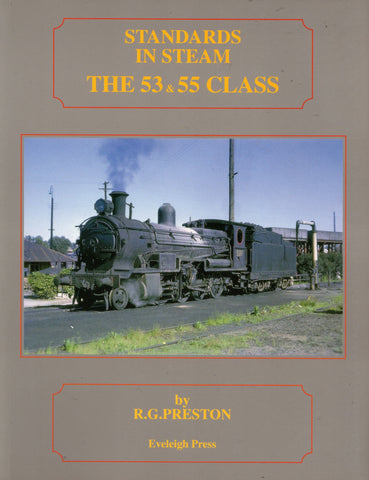Standards in Steam: The 53 & 55 Class -Softcover- (ASCR-53-55S)
Product No.: ASCR-53-55S
Title: Standards in Steam: The 53 & 55 Class -Softcover-
Author(s): Preston, R.G.
Illustrator(s): N/A
Publisher: Eveleigh Press
ISBN: 1876568127
Condition: New
Binding: Softcover
Dust Jacket: No Jacket
Edition: 1st Edition
Publication Year: 2000
Features: 242 Pages with Black/White Photos.
The 53 & 55 class are a class of 2-8-0 steam locomotives built for and operated by the New South Wales Government Railways of Australia. The 53 class of locomotive was designed by the New South Wales Government Railways as a modification of the earlier T(524)-class, after 1924 classified 50-class. All the coupled wheels had flanges and a certain amount of side movement was given to the middle pairs with a laterally operating knuckle joint being provided in the middle section of the coupling rods.
The Clyde Engineering Company delivered the first locomotive in April, 1912 and, by November, 1917, a total of 190 were in service, 160 from Clyde and 30 from the NSWGR Eveleigh Workshops. Most were fitted with superheaters when built and some fitted at a later date. The superheaters caused some initial difficulties, giving the class a bad name. There was also a problem with the locomotives being unbalanced, causing speed restrictions to be imposed to avoid rough riding and track damage. Following further investigations, 24 of the class were re-balanced and these were permitted to operate at a faster speed which made them useful on Wollongong suburban passenger services.
When introduced, most of the class were fitted with a standard bogie tender, similar as those attached to the 50-class, although some saw service with Wampu tenders. In the later period of their lives, the majority were fitted with larger turret type tenders. To enable tender first running, many had automatic couplers fitted to the front. Following the removal of the knuckle joints from the coupling rods, flanges from the second coupled and driving wheels and the fitting of boilers standard for 50-class; 53-class and 55-class, they became most useful locomotives. Many were in service right to the end of the steam era, four surviving to the very last day.
The then Commonwealth Railways used the design of these locomotives for their KA-class for the Trans-Australian Railway - The 55 cass - A contract was given in 1916 to Clyde Engineering Company of Granville for the construction of 300 K-class locomotives. Following experiments with Southern type valve gear on an earlier class, Edward Lucy, the Chief Mechanical Engineer of the N.S.W.G.R., proposed its installation on these locomotives. The use of Southern valve gear was rare on locomotives operating outside the United States of America. The first of the class, then classified as K1353, entered traffic on 29 November, 1918. Due to financial difficulties at Clyde Engineering, the next member did not appear for a further two years. Meanwhile, the contract had been reduced to just 120 locomotives. All were in service by March, 1925 and were fitted with a Wampu type tender.
The last thirty of the class were fitted with self-cleaning smokeboxes and had other modifications. The members of this class spent most of their days attached to depots at Enfield, Goulburn, Harden, Junee and Cowra. They were seldom used on western or northern lines. With the discontent and industrial action in the coalfields following World War II, it was decided in 1946 to convert some of the class to oil burners. The 55-class was chosen as the outside valve gear gave more room for the installation of the new equipment, which included altered firebox and smokebox. The tenders were fitted with a 2,400-imperial-gallon (11,000 l; 2,900 US gal) fuel tank.
The fuel oil was injected into the firebox by a jet of steam from the locomotive boiler, the flow being controlled by the fireman. The first six locomotives converted were fitted to burn distillate which was five times the cost of coal firing, although it was hoped that reduced servicing times would offset some of that extra cost. When cheaper crude oil became available, the locomotives were again modified to allow them to burn this heavier product. This required the installation of heating coils in the tank and pre-heating adjacent to the burner to ensure com



